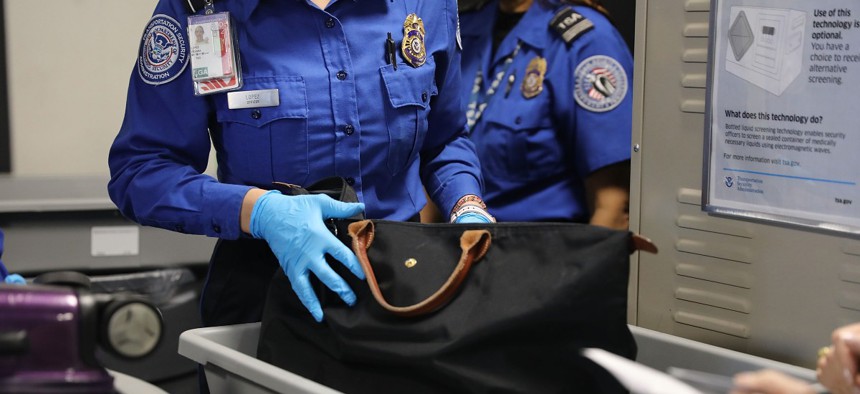
A Transportation Security Administration (TSA) worker screens luggage at LaGuardia Airport on September 26, 2017 in New York City. Spencer Platt/Getty Images
New ‘More Flexible’ TSA Screening Systems Debut in Las Vegas
A collaboration between the TSA and Homeland’s Science & Technology Directorate yields compact baggage screening.
The Department of Homeland Security announced on Tuesday that it unveiled new baggage screening technology for smaller airports, designed specifically for the Transportation and Security Administration to implement where conventional security systems cannot fit.
The baggage scanning system, named the Reduced Form Factor-Computed Tomography, was developed in a joint effort by the TSA and the DHS’s Science and Technology Directorate. The screening technology works to construct three-dimensional images of baggage contents.
The ultimate goal of this system, part of the larger Screening at Speed Program within the S&T, is to reduce the number of physical baggage checks at airport security points.
Massachusetts-based company Integrated Defense and Security Solutions also contributed to the system’s development, underscoring the recent public-private partnerships touted by President Joe Biden’s administration.
“The RFF-CT system is an opportunity to decrease size, weight and power, making the system more adaptable to smaller security checkpoints common at regional airports,” said John Fortune, S&T’s Screening at Speed program manager. “This system is designed to meet the same TSA detection standards as full-size CT systems, while enabling more flexible, passenger friendly checkpoints.”
A TSA spokesperson told Nextgov that the technology powering the RFF-CT system is similar to that which powers medical CAT scans. It additionally utilizes the same artificial intelligence and machine learning algorithms that power the standard airport CT system to detect objects of interest in carry-on bags.
“The only difference between the conventional system and the RFF-CT system is that it’s footprint is small enough to be installed in the more constrained spaces encountered in checkpoints at many smaller airports,” the spokesperson said.
The S&T and TSA have previously worked to develop other screening systems that have been steadily deployed across U.S. airports over the past three years. The new RFF-CT system works to identify distinct textures and materials within luggage using physically smaller systems.
The system operating at the Las Vegas site will determine whether the TSA elects to deploy the RFF-CT nationwide. Some of the potential next steps include working with vendors for various improvements to the system and additional laboratory testing.
“TSA’s goal is to conduct a one-for-one replacement of current AT X-ray equipment with Checkpoint CT, and having a smaller footprint checkpoint CT provides greater flexibility in achieving that goal,” the spokesperson said.







